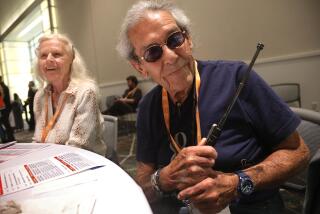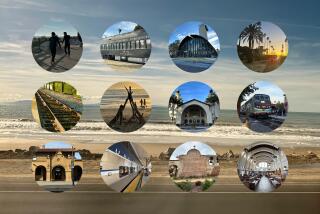The new commuter lifestyle: All aboard
An occasional series on getting from here to there.
--
We are stuffed into this commuter train like filling in a cannoli. Itâs full before we even get to the San Fernando Valley from Oxnard, and those boarding in Moorpark must hunt and peck to find a seat. Many passengers, myself included, only recently heard the clarion call of âall aboard.â Now we are riders on the economic storm as gasoline careens toward five bucks a gallon.
Metrolinkâs train cars clearly were designed for the trim traveler. We sit in little commuter quadripods, two riders facing two more. The seats are narrow, cramped, and they shape my rear into a cube that lasts for hours after I disembark. To cram in the maximum number of seats, Metrolink has apparently decreed legroom an extravagance. In each quadripod, there is only room for two sets of knees.
But the tight quarters of our daily journeys have catalyzed train friendships. I eavesdrop on those around me who chat over the clack-clack of the wheels: Ron has gotten married, and they had an exotic honeymoon; everyone is thrilled for him. Today, Annaâs granddaughter is here, riding the train with her to spend the weekend. Bill will be back on the train next week -- heâs finally getting over the flu.
Nearly every dialogue on board soon turns to The Conversation: how our foreign oil addiction has forced us out of our cars. We donât broach the scary issues underlying the more than 50% rise in gas prices in only a year -- the still-weakening U.S. dollar, our decades-long devotion to stupidly big vehicles named Armada or Titan, the burgeoning world demand for oil. Such truths feel so discouraging that we simply donât take the conversation there.
We chat, instead, about the pundit who accurately, and to much scoffing, predicted four bucks a gallon -- and who now says it will hit eight. And how, so predictably, our presidential candidates wonât address that prognosis. We want someone to make the prices retreat again, and the Blue Man and the Red Man say whatever will make us believe that he (but not the other guy) has the power to make that happen. Yet, despite our desires and our all-American penchant to drive mindlessly, we riders are settling into the train, and through its windows those giant vehicles begin to look a little un-American now.
Personally, I didnât make this shift to public transportation to be a good citizen. I didnât volunteer to help us consume less oil as a nation. But I have run my numbers, and they look good on more than one level. By switching to the train (and then a subway and then a bus) for a 130-mile round trip between Ventura and downtown Los Angeles, I am not pumping 32 gallons of gas a week into my van that I otherwise would. Thatâs more than a barrel and a half of oil, and as I look around at my knee-knocking fellow passengers, I try to do the math, wondering if we are a collective dent in the roughly 80 million barrels of oil the U.S. imports each week.
âWell, the train is finally what it was intended to be -- transportation,â says one rider as she adjusts her ample body in the seat. The cost of gas has trumped drivingâs other worst qualities -- stress, wasted hours, basic hatred of other drivers -- and has pried our selfish hands from the wheel. We may well be in these tight little seats to stay, for we are not so much passengers as hostages, and we cannot afford to change our minds.
More to Read
Sign up for The Wild
Weâll help you find the best places to hike, bike and run, as well as the perfect silent spots for meditation and yoga.
You may occasionally receive promotional content from the Los Angeles Times.






